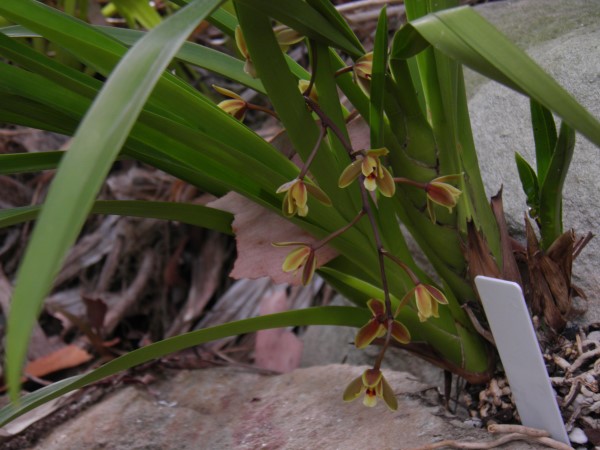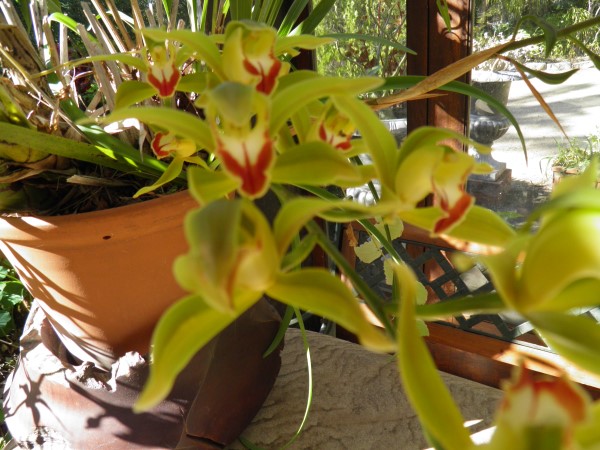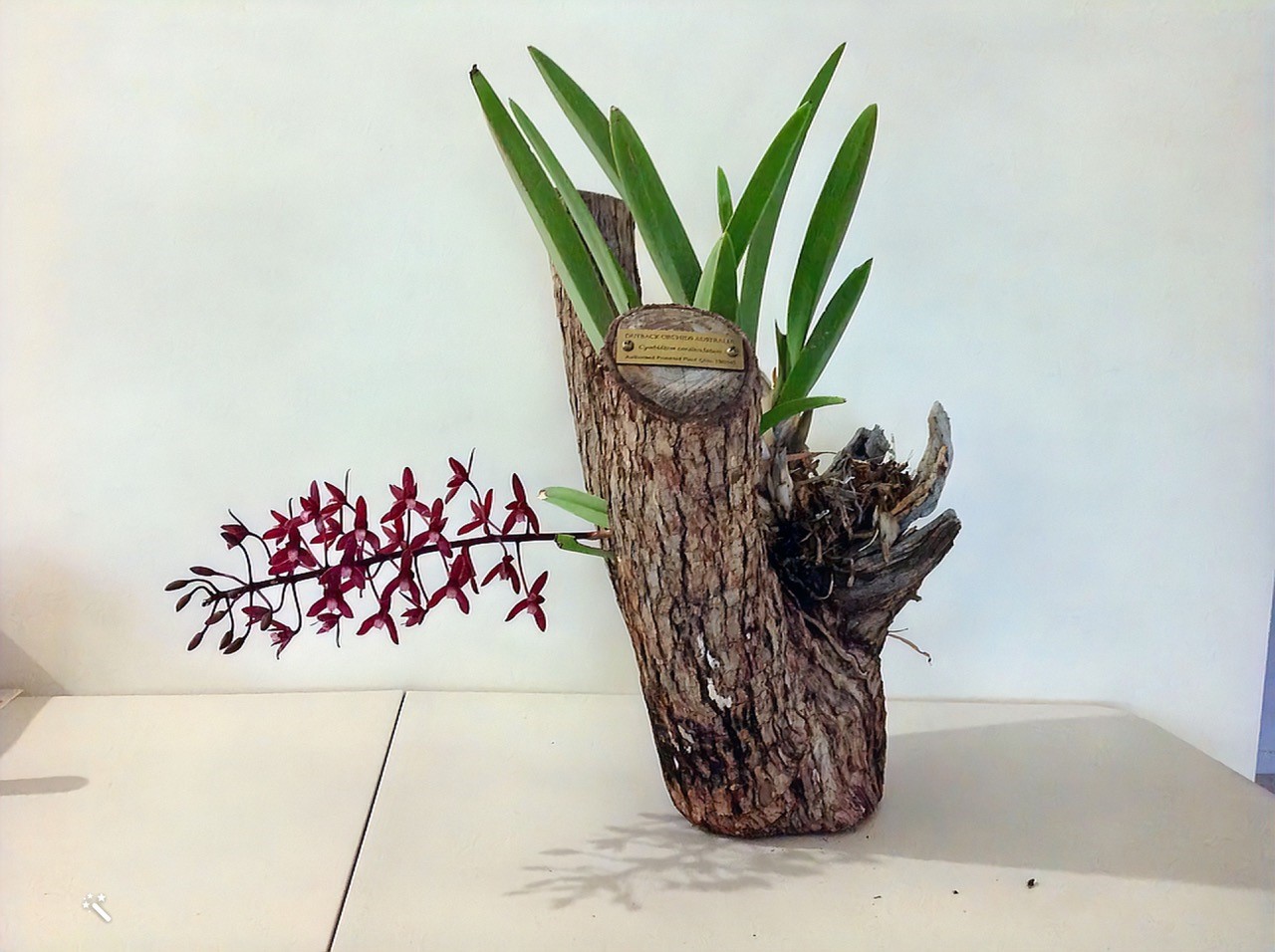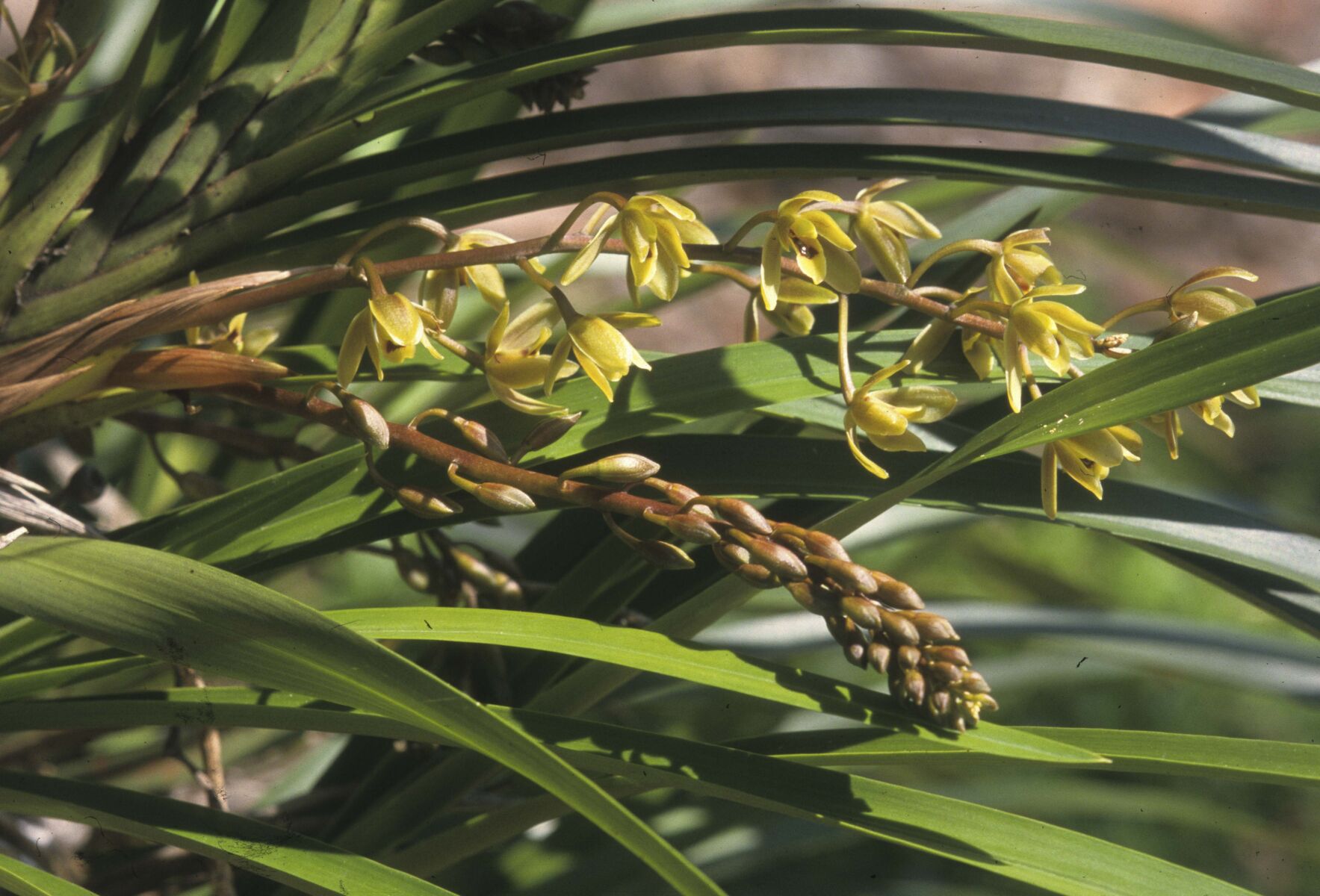


Return to Orchid Growing
CYMBIDIUM SPECIES
GROWING HINTS
GROWING HINTS

CYMBIDIUM SPECIES
We have 3 Native Cymbidiums that are all easily grown in Brisbane:
Madidum is found from Cape York to mid-north coast of New South Wales and is found in hollows and crooks of branches where a lot of jungle detritus has collected and it likes shady conditions in or near rainforests of sea level up to 1300 meters in elevation with conical, ovoid pseudobulbs carrying up to 10, linear, acute, long leaves that blooms in the late winter through summer on a basal, pendant to arcuate, few to many flowered, 30 to 60 cm long, racemose inflorescence carrying faintly fragrant, fleshy flowers.
Clumps can grow to 2 metres wide and they have a large and extensive root system that can roam 10 metres or more. In some areas of its growing range it will receive more than 2 metres of rainfall in the year. It very often will be found growing high up in the rainforest trees with Birdsnest Ferns and Staghorn and Elkhorn ferns.
It flowers from August to February over the warmer months of the year and it is not uncommon to see 100’s of pods hanging on big clumps of the orchid after its flowering season, being pollination by native bees and other insects.
This species is a lot bigger in physical size than the other 2 native Cym species, but the flowers are around the same size usually for all 3 species - give or take a few mm.
Suave: Cymbidium suave is a leafy clumping orchid which sometimes resembles a Lomandra. It is usually seen growing in eucalypt trees as an epiphyte.
It grows to about 0.5 m tall by 0.5 m or more wide and has attractive yellow flowers in spring and summer.
The leaves are green and linear, to 60 cm long and 2 cm wide, leathery and slightly V-shaped in cross section.
The yellow flowers are produced in showy inflorescences to about 30 cm long, with up to 50 flowers. The inflorescences tend to arch over or be pendulous. Flowers are about 3 cm x 3 cm.
It typically grows in woodland and forest in the hollows of old trees or in fallen, decaying trees. It tends to look like Lomandra longifolia from a distance. It has a large geographic range, occurring between Cooktown in Queensland to Bega in New South Wales and as far inland as Tamworth.
Canaliculatum: The strikingly different clones of the northern Australia 'Sparkesii' form could easily make a wonderful collection on its own. Southern forms vary in colour from white through to yellow and the relatively common green-brown, all with differing degrees of markings and colour intensity. There is also an alba form with apple-green petals and sepals and a pure white lip.
Being a predominantly inland species, it requires a much drier cultural environment than either Cym. suave or Cym. madidum. It is found up through central and northern NSW into Queensland to Cape York Peninsula, then across the Gulf country into Arnhem Land and as far west as the Derby area in Western Australia. In eastern Australia it is almost always located on the drier western flank of the Great Dividing Ranges. In far north Queensland, it may be found much closer to the coast. This environment gives an immediate indication to its cultural needs. While its southern occurrences would endure cold winters and hot dry summers, the northern forms thrive under warmer conditions overall but with pronounced wet and dry seasons.
CYMBIDIUM lowianum is from China’s south west and is very easy to grow here in Brisbane. Grow in terracotta pots in orchid bark in morning sun. It flowers in August. The flowers are green coloured and arch downwards.
Madidum is found from Cape York to mid-north coast of New South Wales and is found in hollows and crooks of branches where a lot of jungle detritus has collected and it likes shady conditions in or near rainforests of sea level up to 1300 meters in elevation with conical, ovoid pseudobulbs carrying up to 10, linear, acute, long leaves that blooms in the late winter through summer on a basal, pendant to arcuate, few to many flowered, 30 to 60 cm long, racemose inflorescence carrying faintly fragrant, fleshy flowers.
Clumps can grow to 2 metres wide and they have a large and extensive root system that can roam 10 metres or more. In some areas of its growing range it will receive more than 2 metres of rainfall in the year. It very often will be found growing high up in the rainforest trees with Birdsnest Ferns and Staghorn and Elkhorn ferns.
It flowers from August to February over the warmer months of the year and it is not uncommon to see 100’s of pods hanging on big clumps of the orchid after its flowering season, being pollination by native bees and other insects.
This species is a lot bigger in physical size than the other 2 native Cym species, but the flowers are around the same size usually for all 3 species - give or take a few mm.
Suave: Cymbidium suave is a leafy clumping orchid which sometimes resembles a Lomandra. It is usually seen growing in eucalypt trees as an epiphyte.
It grows to about 0.5 m tall by 0.5 m or more wide and has attractive yellow flowers in spring and summer.
The leaves are green and linear, to 60 cm long and 2 cm wide, leathery and slightly V-shaped in cross section.
The yellow flowers are produced in showy inflorescences to about 30 cm long, with up to 50 flowers. The inflorescences tend to arch over or be pendulous. Flowers are about 3 cm x 3 cm.
It typically grows in woodland and forest in the hollows of old trees or in fallen, decaying trees. It tends to look like Lomandra longifolia from a distance. It has a large geographic range, occurring between Cooktown in Queensland to Bega in New South Wales and as far inland as Tamworth.
Canaliculatum: The strikingly different clones of the northern Australia 'Sparkesii' form could easily make a wonderful collection on its own. Southern forms vary in colour from white through to yellow and the relatively common green-brown, all with differing degrees of markings and colour intensity. There is also an alba form with apple-green petals and sepals and a pure white lip.
Being a predominantly inland species, it requires a much drier cultural environment than either Cym. suave or Cym. madidum. It is found up through central and northern NSW into Queensland to Cape York Peninsula, then across the Gulf country into Arnhem Land and as far west as the Derby area in Western Australia. In eastern Australia it is almost always located on the drier western flank of the Great Dividing Ranges. In far north Queensland, it may be found much closer to the coast. This environment gives an immediate indication to its cultural needs. While its southern occurrences would endure cold winters and hot dry summers, the northern forms thrive under warmer conditions overall but with pronounced wet and dry seasons.
CYMBIDIUM lowianum is from China’s south west and is very easy to grow here in Brisbane. Grow in terracotta pots in orchid bark in morning sun. It flowers in August. The flowers are green coloured and arch downwards.
Let nature be your guide

























